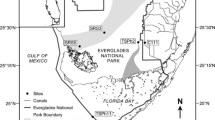Abstract
High-resolution diffuse reflectance spectra in the visible and near-infrared wavelengths were used to predict chemical properties of sediment samples obtained from Lake Okeechobee (FL, USA). Chemometric models yielded highly effective prediction (relative percent difference (RPD) = SD/RMSE >2) for some sediment properties including total magnesium (Mg), total calcium (Ca), total nitrogen (TN), total carbon (TC), and organic matter content (loss on ignition (LOI)). Predictions for iron (Fe), aluminum (Al), and various forms of phosphorus (total P (TP), HCl-extractable P (HCl-P), and KCl-extractable P (KCl-P)) were also sufficiently accurate (RPD > 1.5) to be considered useful; predictions for other P fractions as well as all pore water properties were poor. Notably, scanning wet sediments resulted in only a 7 % decline in RPD scores. Moreover, interpolation maps based on values predicted from wet sediment spectra captured the same spatial patterns for Ca, Mg, TC, TN, and TP as maps derived directly from wet chemistry, suggesting that field scanning of perpetually saturated sediments may be a viable option for expediting sample analysis and greatly reducing mapping costs. Indeed, the accuracy of spectral model predictions compared favorably with the accuracy of kriging model predictions derived from wet chemistry observations suggesting that, for some analytes, higher density spatial sampling enabled by use of field spectroscopy could increase the geographic accuracy of monitoring for changes in lake sediment chemical properties.







Similar content being viewed by others
References
Bogrekci, I., & Lee, W. S. (2005a). Improving phosphorus sensing by eliminating soil particle size effect in spectral measurement. Transactions of the American Society of Agricultural Engineers, 48(5), 1971–1978.
Bogrekci, I., & Lee, W. S. (2005b). Spectral measurement of common soil phosphates. Transactions of the American Society of Agricultural Engineers, 48(6), 2371–2378.
Brown, D. J., Shepherd, K. D., Walsh, M. G., Mays, M. D., & Reinsch, T. G. (2006). Global soil characterization with VNIR diffuse reflectance spectroscopy. Geoderma, 132(6), 273–290.
Chang, C., Laird, D. A., Mausbach, M. J., & Hurburgh Jr., C. R. (2001). Near-infrared reflectance spectroscopy-principal components regression analyses of soil properties. Soil Science Society of America Journal, 65(2), 480–490.
Cohen, M. J., Prenger, J. P., & DeBusk, W. F. (2005). Visible-near infrared reflectance spectroscopy for rapid, nondestructive assessment of wetland soil quality. Journal of Environmental Quality, 34(4), 1422–1434.
Dunn, B. W., Batten, G. D., Beecher, H. G., & Ciavarella, S. (2002). The potential of near-infrared reflectance spectroscopy for soil analysis—a case study from the riverine plain of South-Eastern Australia. Australian Journal of Experimental Agriculture, 42(5), 607–614.
Fearn, T. (2000). Savitzky-golay filters. NIR News, 6, 14–15.
Fisher, M. M., Reddy, K. R., & James, R. T. (2005). Internal nutrient loads from sediments in a shallow, subtropical lake. Lake Reserv Manag., 21(3), 338–349.
Florida Department of Environmental Protection (2001). Total Maximum Daily Load for Total Phosphorus Lake Okeechobee, Florida.
Havens, K. E., & Steinman, A. D. (2015). Ecological responses of a large shallow Lake (Okeechobee, Florida) to climate change and potential future hydrologic regimes. Environmental Management, 55(4), 763–775.
Huang, H., Yu, H., Xo, H., & Ying, Y. (2008). Near infrared spectroscopy for on/in-line monitoring of quality in foods and beverages: a review. Journal of Food Engineering, 87, 303–313.
James, R. T., Jones, B. L., & Smith, V. H. (1995). Historical trends in the Lake Okeechobee ecosystem II. Nutrient budgets. Arch fur Hydrobiolie, 107, 25–47.
Kodikara GRL, Woldai T, van Ruitenbeek FJA, Kuria Z, van der Meer F, Shepherd KD, van Hummel GJ. 2012. International Journal of Applied Earth Observation and Geoinformation, 14, 22–32.
Kooistra, L., Wanders, J., Epema, G. F., Leuven, R. S. E. W., Wehrens, R., & Buydens, L. M. C. (2003). The potential of field spectroscopy for the assessment of sediment properties in river floodplains. Analytica Chimica Acta, 484(2), 189–200.
Lee, W. S., Sanchez, J. F., Mylavarapu, R. S., & Choe, J. S. (2003). Estimating chemical properties of Florida soils using spectral reflectance. Transactions of the American Society of Agricultural Engineers, 46(5), 1443–1453.
Malley, D. F., & Williams, P. C. (1997). Use of near-infrared reflectance spectroscopy in prediction of heavy metals in freshwater sediment by their association with organic matter. Environmental Science & Technology, 31(12), 3461–3467.
Moore, P. A., Reddy, K. R., & Fisher, M. M. (1998) Phosphorus flux between sediment and overlying water in Lake Okeechobee, Florida: spatial and temporal variations. Journal of Environmental Quality, 27(6), 1428–1439.
Mulvaney R.L. 1996. Nitrogen-inorganic forms. In Methods of soil analysis, part 3—Chemical methods. Madison, WI, USA: Soil Science Society of America.
Nilsson, M. B., Dabakk, E., Korsman, T., & Renberg, I. (1996). Quantifying relationships between near-infrared reflectance spectra of lake sediments and water chemistry. Environmental Science & Technology, 30(8), 2586–2590.
Norris, K. H., Barnes, R. F., Moore, J. E., & Shenk, J. S. (1976). Predicting forage quality by infrared reflectance spectroscopy. Journal of Animal Science, 43(4), 889–897.
Reddy K.R., White J.R., Fisher M.M., Pant H.K., Wang Y., Grace K., Harris W.G. 2002. Potential impacts of sediment dredging on internal phosphorus load in Lake Okeechobee.
Shepherd, K. D., & Walsh, M. G. (2002). Development of reflectance spectral libraries for characterization of soil properties. Soil Science Society of America Journal, 66(3), 988–998.
Shepherd, K. D., Cheryl, A. P., Catherine, N. G., & Bernard, V. (2003). Rapid characterization of organic resource quality for soil and livestock management in tropical agroecosystems using near-infrared spectroscopy. Agronomy Journal, 95(5), 1314–1322.
Shepherd, K. D., Shepherd, G., & Walsh, M. G. (2015). Land health surveillance and response: a framework for evidence-informed land management. Agricultural Systems, 132, 93–106.
Acknowledgments
The South Florida Water Management District provided funding for this research. The authors thank Yu Wang and Gavin Wilson of the Wetland Biogeochemistry Laboratory at the University of Florida for sample analysis assistance and Benjamin Loughran for field assistance.
Author information
Authors and Affiliations
Corresponding author
Rights and permissions
About this article
Cite this article
Vogel, W.J., Osborne, T.Z., James, R.T. et al. Spectral prediction of sediment chemistry in Lake Okeechobee, Florida. Environ Monit Assess 188, 594 (2016). https://doi.org/10.1007/s10661-016-5605-8
Received:
Accepted:
Published:
DOI: https://doi.org/10.1007/s10661-016-5605-8




